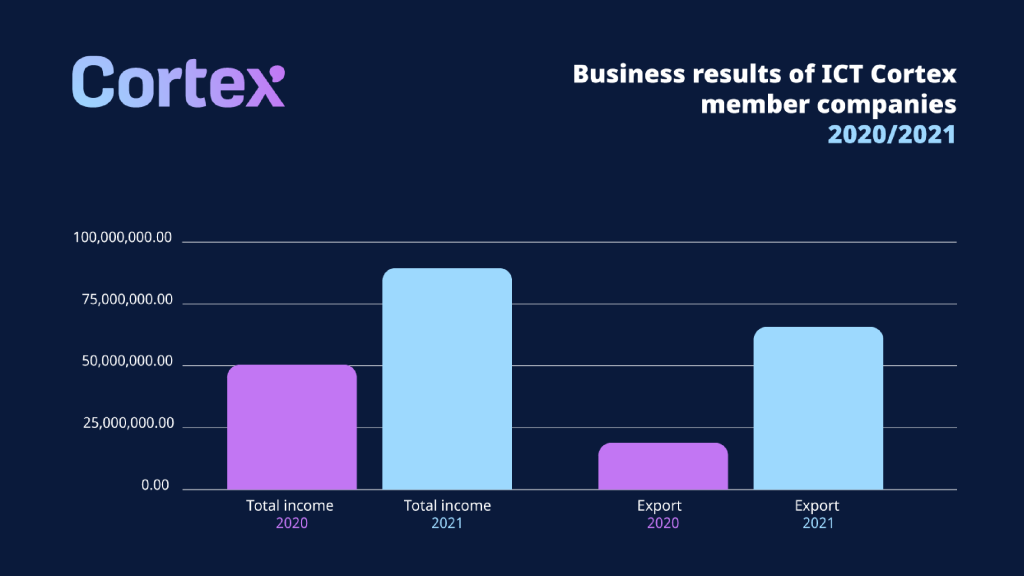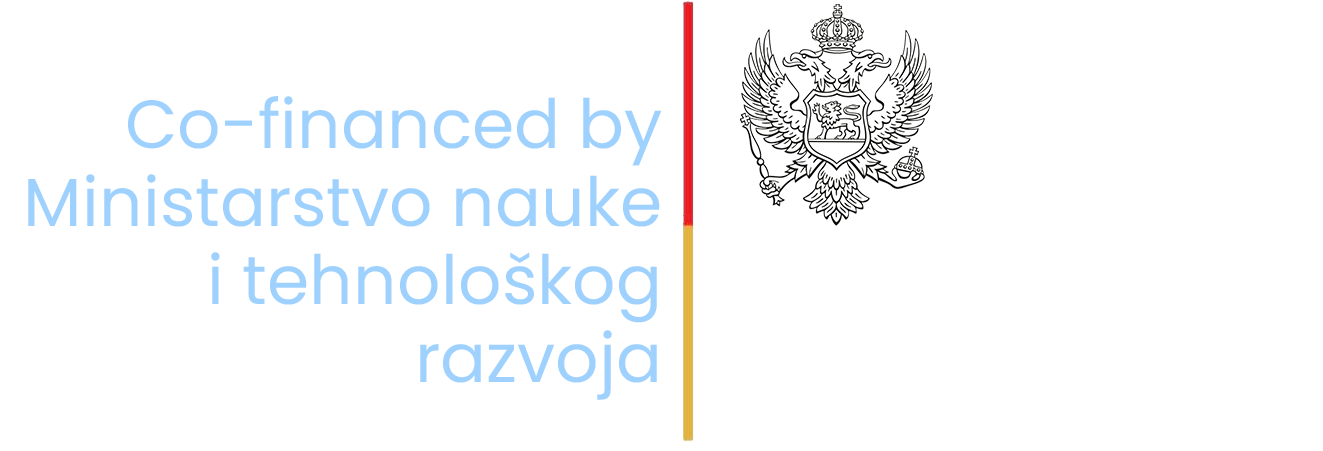Despite the pandemics, IT companies are growing in all business segments

ICT Cortex – cluster for information technology, innovation, education, design, and technological development of Montenegro, analyzed the business results of the 30 most successful IT companies in Montenegro, and as the criteria for ranking success, the amount of revenue in 2020 was taken. The total revenues of the analyzed companies in 2020 amounted to € 56,256,439, which is 18% more than in the previous year, while the total profit doubled in comparison to 2019 and amounted to € 10,916,675. Special attention was paid to the results of 10 founding members of ICT Cortex: Alicorn, Amplitudo, Bild Studio, Codeus, Codingo, Coinis, Data Design, Fleka, Logate, and Oykos Development, which successfully closed the business year with growth in all segments. ICT cluster members achieved revenue growth of 25%, of which 79.12% of revenue generated was exports – a total of € 12,183,955.99. “For now, the IT sector is successfully resisting the crisis caused by the coronavirus pandemic, and our goal is to create conditions for the IT sector to become the backbone of Montenegro’s future development and a strong economic activity that will create leading export products. We are proud of the business results of our founding members, and we are especially pleased with the fact that IT exports in 2020 increased by almost 30%. The outcome of the analysis confirms that IT is a promising branch, export-oriented, and further investment in IT can certainly provide an incentive to recover and strengthen the entire economy. – said Tanja Dukić, Marketing Director of ICT Cortex. The number of employees in the companies in 2020 was 704, of which 278 people are employed the founding members of ICT Cortex, which plan to create over 100 jobs by the end of 2021. “IT companies have increased the number of employees compared to 2019, and the growth trend is expected this year as well because companies need to hire new staff. As an inclusive association, we aim to unite the IT community and jointly achieve an increase in the number of employees and the necessary skills for the development of the IT sector, which will ultimately reduce the outflow of talent from Montenegro. ” – adds Dukić. It is expected that 2021 will be very successful. According to a survey conducted by the executive office of ICT Cortex among the founding members, the planned revenue growth in 2021 will be about 30%, of which as much as 80% will be generated on the basis of projects for foreign markets. ICT Cortex is an association that brings together the innovative IT community, with the aim of being a leader in the digital transformation of the economy and public administration, as well as improving the framework and ecosystem necessary to ensure digital innovation in industry and education. “The cluster has 11 members so far, and we are pleased that many IT companies have already expressed a desire to become part of the ICT Cortex family. We invite all interested companies and organizations to join us, and the request for joining can be sent to the email address contact@ictcortex.me “- conclude from the ICT cluster Cortex.
ICT Cortex – compass for digital transformation of Montenegro

On March 9, 2021, the European Commission presented the vision and directions of the digital transformation of Europe until 2030. You can find the original announcement at this link, and at the same link you can also download the complete document “2030 Digital Compass: the European way for the Digital Decade”, which the EU Commission sent to the European Parliament, the Council of Europe, the European Economic and Social Committee and the Committee region. The mentioned strategy is very important for defining the strategic directions for the digital transformation of Montenegro, and you can read below how the president of the assembly of ICT Cortex – Branimir Bukilić, views it from an expert point of view. “The vision for the EU digital decade is developed around four key coordinate points: skills, infrastructure, economy, and public administration, while the EU has strategically determined these four points as goals that must be achieved by 2030. We are pleased with the fact that we at ICT Cortex have recognized the relevant key points as the basis of our association, in order to provide the conditions for their realization and that we are therefore aware of the need to speed up the digital transformation processes of Montenegro. When it comes to the coordinate points listed in the strategy, I’ll start with skills. Digital skills are put in the foreground because without them all other goals are not achievable. The EU admits that it lags significantly behind other markets in terms of digital skills. It is even stated that the key digital technologies are still produced outside the EU, which is also the case with Montenegro. We understand that we are forced to import hardware systems, but we must work on educating new and existing staff, and increasing digital knowledge both qualitatively and quantitatively in companies that develop IT products and solutions so that we have the opportunity for domestic IT companies to be the bearers of digital transformation. Digital education of citizens is mentioned as an important segment in the process: “It is necessary for us to have digitally capable citizens who will be users of modern IT solutions and services, which will lead to a significant acceleration of Public Administration and the economy, which inevitably leads to economic growth. And we have to do this at an accelerated pace because Montenegro’s goal must not only be to reach the EU level, but to reach the level of countries that are responsible for the development of digital services, which is what the EU itself strives for. The EU target of 80% of the population with basic digital skills does not seem so far-fetched at first glance. However, we have to be careful with this assessment.” As a link between the above and the goals of ICT Cortex, Bukilić states that the activity of the cluster aims to encourage the creation of an environment for the significantly faster creation of new IT personnel. The results of the research, which were carried out at the end of last year, showed that over 86% of IT companies or the IT sector in other companies need to create new jobs, and over 90% of respondents determined that they have difficulties in finding professional staff who can be carriers of development. For this reason, all members of the association are involved in the creation of new programs for the education of future programmers, designers, project managers, etc. Infrastructure is an inevitable factor in any field, including IT. The EU has set high goals in this area, which are mainly related to improving the very poor share of European manufacturers of microchips, cloud solutions, and supercomputers at the global level. The goal of improving the network infrastructure, that is, the availability and quality of the Internet connection, was also recognized. “Technologically speaking, a gigabit connection for every citizen and 5G across the entire territory of the EU may not seem like unattainable goals like in other critical areas. Somehow we in Montenegro also believe that these goals are possible or that we can get significantly closer to them by 2030. However, the economic sustainability of these goals is questionable in Montenegro. Montenegro’s aspiration to join the European Community is also justified by the fact that it is practically impossible for us to work independently on the development of microchips or supercomputers and even cloud computing. Even when we are in the EU, we should focus on other areas, and use the relevant resources of other members of the community. As for Montenegro, I would also include legislation in the infrastructure. It is necessary to modernize the existing legal solutions concerning digital infrastructure because we are aware that they have not been changed for a long time, that is to say, the dynamics of their harmonization do not follow the dynamics of technological development. In addition to these essential legal solutions, we must also work on the implementation of the adopted legal solutions that will ensure the strengthening of the domestic IT industry, facilitate and relieve new employment in the IT industry, that is, in innovative activities, trace new directions of digital education of citizens through primary, secondary and higher education. I see ICT Cortex as a particularly important link in these segments. Strengthening the IT industry will contribute to its competitiveness, the ability to carry out the digital transformation of Public Administration and the economy and create new export potentials, and these are the main goals of ICT Cortex,” concludes Bukilić. The economy, as the carrier of the economy of every society, is the third key point of the EU Digital Compass. Experiences due to the Covid 19 pandemic both in the EU and in our country indicate that the adoption of digital skills has become necessary for many companies. Unfortunately, this global scourge has had the effect of increasing businessmen’s awareness of the need to digitize their business processes. The EU Commission predicts that by 2030, digital technologies such as 5G, IoT – Internet of Things, supercomputers, artificial
ICT Cortex – kompas za digitalnu transformaciju Crne Gore?

Osvrt na prezentovanu EU Strategiju digitalne transformacije do 2030.godine iz ugla predsjednika skupštine ICT Cortex Evropska komisija je 9.marta 2021. godine predstavila viziju i pravce digitalne transformacije Evrope do 2030. godine. Originalno saopštenje možete pronaći na ovom linku, a na istom se može preuzeti i kompletan dokument “2030 Digital Compass: the European way for the Digital Decade.”, koji je EU komisija uputila Evropskom parlamentu, Savjetu Evrope, Evropskom ekonomskom i socijalnom komitetu i Komitetu regija. Pomenuta strategija je veoma važna za definisanje strateških usmjerenja za digitalnu transformaciju Crne Gore, a kako na istu, iz stručnog ugla, gleda predsjednik skupštine ICT Cortexa – Branimir Bukilić, možete pročitati u nastavku. “Vizija za EU digitalnu dekadu se razvija oko četiri ključne koordinatne tačke: vještine, Infrastruktura, privreda, javna uprava, dok je EU ove četiri tačke strateški odredila ciljevima koji se moraju postići do 2030. Godine. Raduje nas činjenica da smo mi u ICT Cortex-u prepoznali predmetne ključne tačke kao temelj našeg udruživanja, radi obezbjeđivanja uslova za realizaciju istih i da smo samim tim svjesni potrebe da ubrzamo procese digitalne transformacije Crne Gore. Kada su u pitanju koordinatne tačke koje se navode u strategiji, počeću od vještina. Digitalne vještine se stavljaju u prvi plan jer bez njih ni svi ostali ciljevi nisu ostvarivi. EU priznaje da na polju digitalnih vještina značajno zaostaje za drugim tržištima. Čak se navodi da su i dalje ključne digitalne tehnologije proizvedene van EU, što je slučaj i sa Crnog Gorom. Razumijemo da smo primorani da hardverske sisteme uvozimo, ali moramo raditi na edukaciji novih i postojećih kadrova, povećanju digitalnih znanja i kvalitativno i kvantitativno u kompanijama koje se bave razvojem IT proizvoda i rješenja, kako bismo bili u prilici da domaće IT kompanije budu nosioci digitalne transformacije. Kao bitan segment u procesu, navodi se i digitalna edukacija građana: “Neophodno nam je da imamo digitalno sposobne građane koji će biti korisnici savremenih IT rješenja i servisa, a koji će dovesti do značajnog ubrzavanja Javne uprave i privrede što neminovno dovodi do ekonomskog rasta. I ovo moramo da radimo ubrzanim tempom jer Crnoj Gori ne smije da bude samo cilj dostizanje EU nivoa, nego dostizanje nivoa zemalja nosioca razvoja digitalnih servisa, čemu i sama EU teži. EU target od 80% populacije sa osnovnim digitalnim sposobnostima i ne djeluje na prvi pogled tako daleko. Ipak, moramo biti obazrivi prilikom ove ocjene.” Kao poveznicu navedenog sa ciljevima ICT Cortexa, Bukilić navodi da se djelovanjem klastera želi podstaći stvaranje okruženja za značajno brže kreiranje novih IT kadrova. Rezultati istraživanja, koja su rađeni krajem prošle godine, pokazali su da preko 86% IT preduzeća ili IT sektora u ostalim preduzećima ima potrebu za otvaranjem novih radnih mjesta, a preko 90% ispitanika se odredilo da ima poteškoće u pronalaženju stručnih kadrova koji mogu da budu nosioci razvoja. Iz tog razloga, sve članice udruženja uključene su u kreiranju novih programa za edukaciju budućih programera, dizajnera, menadžera projekata i sl. Infrastruktura je neizbježni faktor u bilo kojoj oblasti, pa i u IT-u. EU je postavila visoke ciljeve u ovoj oblasti koji se uglavnom odnose na poboljšanje veoma lošeg udjela evropskih proizvođača mikročipova na globalnom nivou, cloud rješenja i super kompjutera. Prepoznat je i cilj poboljšanja mrežne infrastrukture, to jest dostupnosti i kvaliteta Internet konekcije. “Tehnološki gledano, gigabitna konekcija za svakog građanina i 5G na cijeloj teritoriji EU, možda i ne djeluju kao nedostižni ciljevi kao što je to u drugim kritičnim oblastima. Nekako i mi u Crnoj Gori smatramo da su ovi ciljevi mogući ili da se možemo njima značajno približiti do 2030. Međutim, ekonomska održivost ovih ciljeva je upitna u Crnoj Gori. Težnja Crne Gore za priključivanje Evropskoj zajednici opravdana je i time da je praktično nemoguće da samostalno radimo na razvoju mikročipova ili superkompjutera, pa čak i cloud computing-a. Čak i kad budemo u EU mi bismo se trebali fokusirati na druge oblasti, a koristiti predmetne resurse drugih članica zajednice. Što se tiče Crne Gore, ja bih u infrastrukturu ubrojao i legislativu. Neophodno je osavremeniti postojeća zakonska rješenja koja se tiču digitalne infrastrukture jer smo svjesni da nisu odavno mijenjani, to jest da svakako dinamika njihovih usklađivanja ne prati dinamiku razvoja tehnologija. Pored tih esencijalnih zakonskih rješenja, moramo raditi i na implementaciji donešenih zakonskih rješenja koja će obezbijediti osnaživanje domaće IT industrije, olakšati i rasteretiti nova zapošljavanja u IT industriji, to jest u inovativnim djelatnostima, trasirati nove pravce digitalne edukacije građana kroz osnovno, srednje i visoko obrazovanje. U ovim segmentima ICT Cortex vidim kao posebno bitnu kariku. Osnaživanje IT industrije će doprinijeti njenoj konkurentnosti, sposobnosti da sprovodi digitalnu transformaciju Javne uprave i privrede i kreira nove izvozne potencijale, a upravo su to glavni ciljevi ICT Cortexa.”, zaključuje Bukilić. Privreda kao nosioc ekonomije svakog društva, jeste treća ključna tačka EU Digitalnog kompasa. Iskustva usled pandemije Covid 19 i u EU i kod nas ukazuju na to da su usvajanja digitalnih vještina postala neophodna za mnoga preduzeća. Nažalost, ova pošast svjetskih razmjera je uticala na povećanje svijesti privrednika o potrebi da digitalizuju svoje poslovne procese. EU Komisija predviđa da će do 2030. godine digitalne tehnologije kao što su 5G, IoT – Internet of Things, super kompjuteri, vještačka inteligencija, robotika i virtuelna realnost biti okosnica novih proizvoda, novih proizvodnih procesa i novih poslovnih modela zasnovanih na poštenom dijeljenju podataka u ekonomiji zasnovanoj na informacijama. Imajući to u vidu, mišljenje Bukilića je da “privreda u Crnoj Gori veoma kasni i za usvajanjem odavno dospupnih tehnologija i servisa, a kamo li da bude spremna na usvajanje novih tehnologija čija dominacija se predviđa do 2030. godine. Da bi bila konkurentna, privreda mora ubrzati poslovne procese i povećati kvalitet u svakoj oblasti. Ubrzanje poslovnih procesa može da bude u koheziji jedino sa implementacijom digitalnih servisa, informacionih sistema, međusobnom digitalnom povezanošću, implementacijom sistema vještačke inteligencije za predviđanja i procjene i automatizaciju donošenja odluka. Kao što je toga svjesna Evropska komisija, i mi moramo biti svjesni da privreda neće moći samostalno da isprati tehnološki razvoj i da joj se mora pomoći. Zato Evropa ima za cilj da duplira fondove namijenjene inovacijama. Neophodno je da i mi bolje iskoristimo EU fondove koji će


